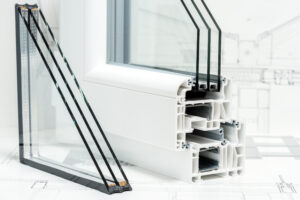To level up your household efficiency, you need triple-pane windows.
Low emissivity, u-factor, solar heat gain, triple pane: words that sound like they’re from a science fiction movie but are, in fact, associated with windows. As you can see, efficient windows aren’t always easy to understand, but Katie Cort makes the challenge easier to digest. Cort is an energy economist at the U.S. Department of Energy’s Pacific Northwest National Laboratory (PNNL), and her team’s research found that despite the new window technologies soon to be available, reaching new heights in energy efficiency will, at least for now, require a new and improved version of a proven technology – triple-pane windows.
In the past two years, Cort and her colleagues at PNNL and the Lawrence Berkeley National Laboratory published a series of reports documenting DOE-sponsored field studies that demonstrate the value of thin triple-pane windows, which were highlighted in the recent article “How triple-pane windows stop energy (and money) from flying out the window.” The studies showed triple-pane windows could increase a home’s window energy performance by 40 percent, all while improving interior comfort and blocking more exterior noise.
“Lower costs, greater availability, and the drive to reduce carbon emissions are pushing us toward a tipping point where triple-pane windows make sense,” the report said. Cort and others expect that the new criteria to qualify for ENERGY STAR® version 7, which takes effect in October of 2023, will create even more demand, especially in the northern part of the country.
In October, I heard her speak at the fall meeting of our parent organization, the National Fenestration Ratings Council. Her speech to the experts at the conference was so clear and compelling that I had to ask a few follow-up questions for us regular folks.
Why are triple-pane windows awesome?
Windows are the weakest link in your home when it comes to energy efficiency. If you live in a cold climate, you could add as much insulation as you can pack in, but that won’t boost your home’s overall insulating power as much as replacing your windows with ones that insulate better.
 If you’re like most people and have the conventional technology – a double-pane window with insulating gas in between the panes – you can only get so far before making the whole window assembly wider.
If you’re like most people and have the conventional technology – a double-pane window with insulating gas in between the panes – you can only get so far before making the whole window assembly wider.
But some new and emerging technologies are helping facilitate higher-performance windows with thinner and more lightweight window assemblies. This includes the so-called thin triples: a three-pane window with an ultra-thin nonstructural middle pane that boosts insulating power. The pane isn’t a weight-bearing element of the window but makes them narrow enough to be installed into conventional double-pane window frames, either in a factory or glazed into an existing home’s frame.
Sounds great, but why aren’t they more popular?
Triple-pane windows are costlier, but in addition to the sticker price, builders can sometimes be reluctant to use something wider and heavier. They are set on their standard dimensions for window thickness. But we are seeing that change, and even the biggest production builders are willing to experiment with thin triples to help meet more stringent codes and standards. Our field validation studies also show they are easily integrated into window frames as replacements for old windows.
There are many exciting technologies to improve double-pane windows – insulating gels and films, windows with automatic tints, and windows that double as solar panels. Shouldn’t I wait for those?
Right now, the best deal for a high-performance window is the conventional triple-pane window. Some of those new technologies will eventually be widely available in future decades, but not yet. So, we think of thin triples as a bridge technology.
 What should I do first? People are talking about heat pumps, efficient windows, electric stoves, and many other things. I can’t afford to buy everything now, so what to prioritize?
What should I do first? People are talking about heat pumps, efficient windows, electric stoves, and many other things. I can’t afford to buy everything now, so what to prioritize?
You need the higher-performance window to really make the best of the other heating and cooling technologies. If you have older, leaky windows and choose to electrify your home by converting an old oil furnace to a heat pump in a cold-weather climate, you will likely end up with thermal comfort issues and some unexpectedly high electric bills during the winter. So, window upgrades should come before a new heat pump.

To read more about Katie’s study’s findings, go to https://www.sciencedaily.com/releases/2022/03/220303162044.htm
